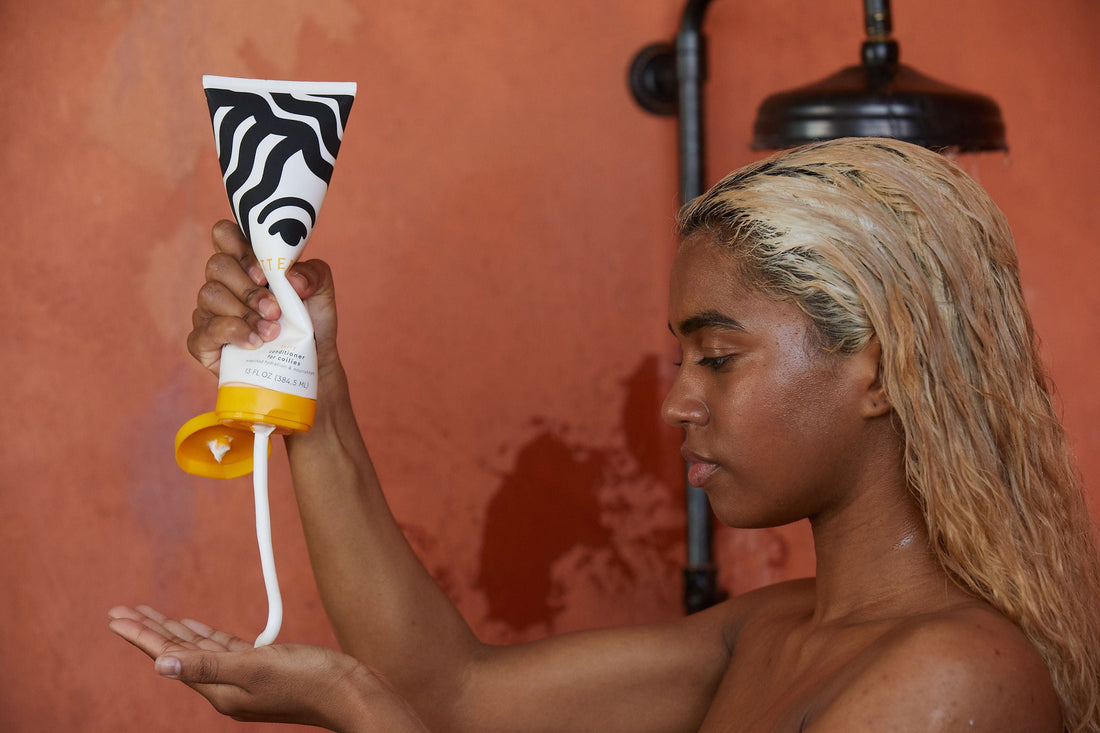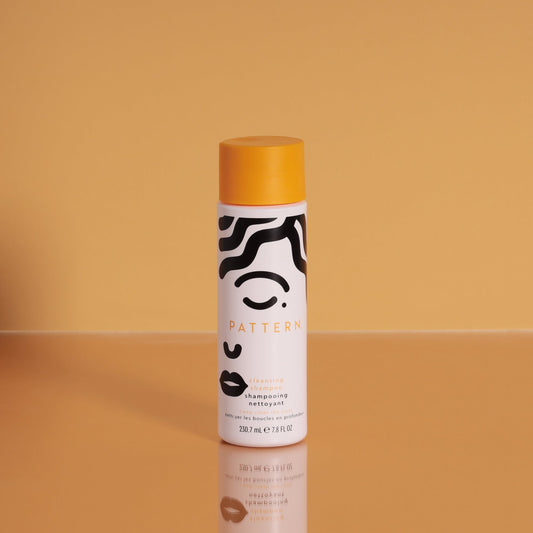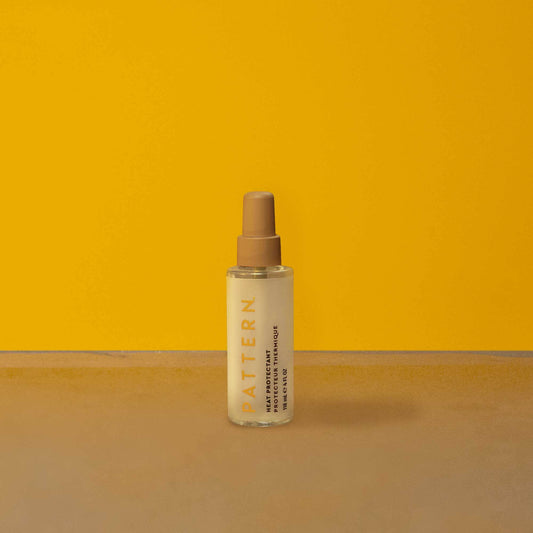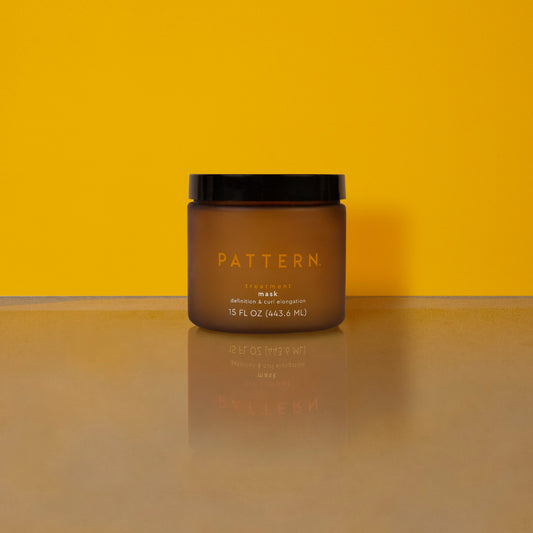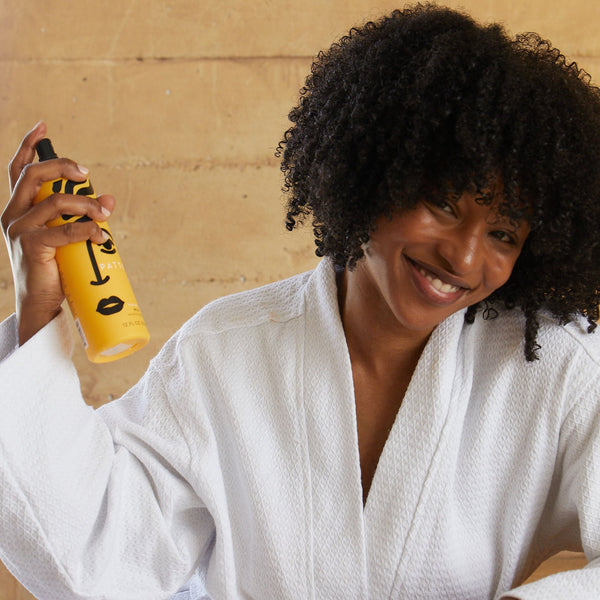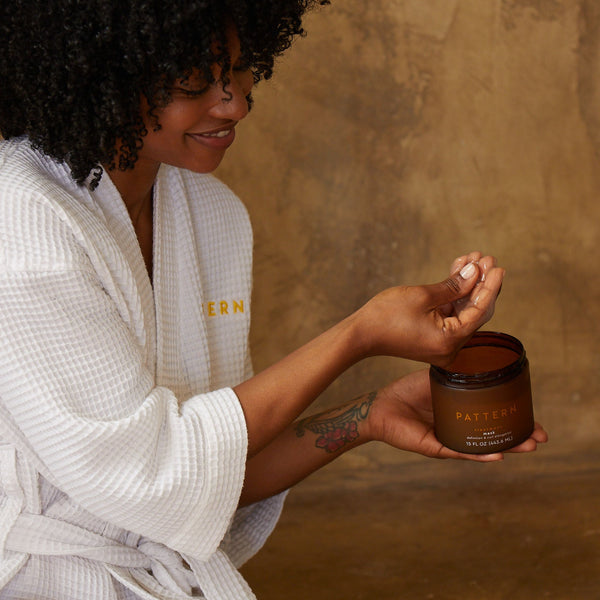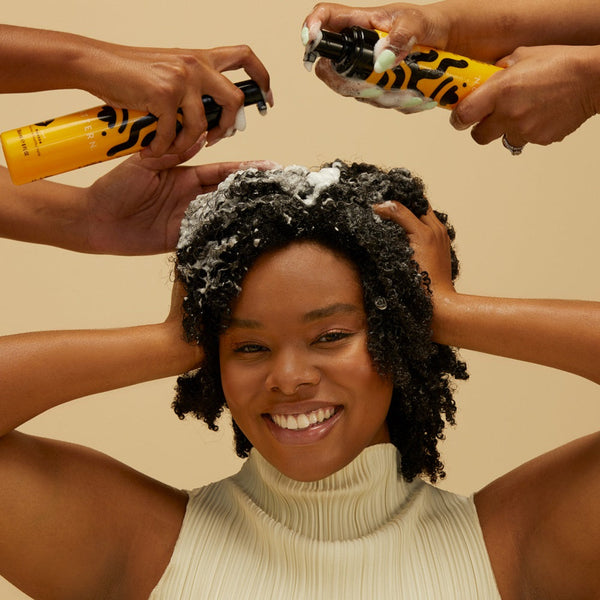It can happen seemingly overnight: One day, your curls are a halo of bouncy, shiny & voluminous spirals. Then, just a few months later, you’re holding curls that could use a little extra TLC.
Huh? What happened?
If you feel your curls entering a “glow down” era, you may be looking at hair damage. From flat ironing to exposing your locks to chlorine, certain habits can reverse your sleek, shiny curls. The good news? By uncovering the root cause of your hair damage, you can prevent further damage & learn how to nourish your curls back to health. To help, we’re breaking down 5 different types of hair damage & exploring various hair-damaging factors so that you can keep your gorgeous locks safe.
What is Hair Damage?
Hair damage is a broad term for any issues that tank the strength & health of your strands. To understand how exactly this can happen, let’s talk about how exactly your hair works.
Your hair shaft is the part of your hair that you can see. It’s made up of three distinct layers that are each formed from keratin (a strong protein). These layers include:
- Medulla – The small inner layer of your hair (not present in certain fine or blonde hair types).
- Cortex – The large middle layer that contains pigment cells that determine your hair’s color.
- Cuticle – The outer layer that retains moisture & gives your hair a smooth, healthy appearance by remaining tightly packed or “closed.”
When any condition harms the structure of these layers, hair damage can come about. On a microscopic level, this may look like a loss of keratin protein, lifted cuticles or a change in the hair’s protein distribution.
What Does Damaged Curly Hair Look Like?
So, what do lifted cuticles & protein loss look like from the outside? Do damaged curls look different than damaged straight hair?
In short, damaged curly hair can present in many ways. While some curl types may face more dryness, everyone’s hair will respond to damage differently. If you’re repeatedly asking, “Is my hair damaged?”, check for these common signs that your locks need a healthy reboot:
- Split ends
- Breakage
- Hair thinning
- Frizz
- Dry or rough texture
- Excessive tangling
- Curl pattern changes
5 Types of Damaged Hair for Curls
Even if you take extreme hair care caution, your curls may still experience dryness, dullness & breakage at times. Sometimes, it can be tough to know just where things went downhill (or down strand).
The good news? You can solve this hairy mystery.
From curling irons to high ponytails, hair foes exist everywhere. Once you diagnose the cause of your hair damage, you can find the appropriate solution to get back on the healthy hair road. Let’s look at the most common & sneaky types of hair damage that can wreak havoc on your curls.
#1 Environmental Damage
You know how your skin gets dry after a walk outside in the cold winter air? Your hair is similarly vulnerable to its environment—and can become damaged from it over time.
Since hair is a porous structure, it’s easily influenced by the weather & substances that interact with it. Consider how these common environmental sources can impact the look & feel of your curls:
- UV light – When you step out into the bright sunshine, it's not just your skin that needs protection. Harmful ultraviolet (UV) radiation from the sun can penetrate the hair cuticle. This can break down pigments & reduce moisture content, leading to faded & dry hair. Fortunately, sprayable hair sunscreen & hats can significantly block UV light from hurting your curls.
- Humidity – Let’s get scientific for a moment—your hair needs hydrogen bonds to stay strong. However, high levels of humidity can weaken these hydrogen bonds, creating more frizz & breakage. On the other hand, when humidity levels are low, it can leave your hair thirstier, weaker & more prone to damage. To break free from humidity’s hold, use curly hair products that provide a boost of hydration & seal it into the hair follicle.
- Pollution – When absorbed by your hair, pollutants like tobacco smoke & car exhaust can penetrate the hair fiber & damage the interior cuticle. Even worse? When these pollutants are free radicals (or oxidizing molecules), they can accelerate hair degradation & aging. To combat pollution’s effects on hair, use a deep cleaning product like PATTERN’s Cleansing Shampoo that contains antioxidant-rich ingredients, like Matcha Green Tea.
#2 Heat Damage
Who doesn’t love a sleek blowout or some romantic barrel curls? However, the blow dryers & curling irons you need to achieve a shaped look are, well, less than warm to your hair.
In fact, heat styling tools are a near fast-track to hair damage—even moderate amounts of heat will break the chemical bonds between hair cells that give your hair its natural texture. Repeated use of high-temperature tools can also denigrate keratin protein, evaporate water content & lift the cuticle. Over time, this may even change the pattern or tightness of your curls.
Some common sources of heat damage include:
- Blow dryers
- Curling irons
- Curling wands
- Diffusers
- Flat irons
If you can’t drop your favorite heat styling tool completely, consider minimizing the damage. First, always use a heat protectant such as our sprayable Heat Protectant on your hair before any hot tool use. Second, stick with hot tools that stay below 300 degrees Fahrenheit, such as the PATTERN Blow Dryer. With care, you can keep the blowout & leave behind the heat damage.
#3 Chemical Damage
Relaxing your hair may seem like an easy way to get a sleek look—but chemical treatments & substances can damage & dull your curls over time.
Chemical damage, or hair damage from applying man-made substances, often strips the hair cuticle’s precious layers away. Before you schedule a root touch-up, get to know these top culprits behind chemical hair damage:
- Hair dye – Despite any temporary mood boosts, those highlights may leave you with permanent hair sadness. Hair dyes often contain powerful chemicals, such as ammonia & hydrogen peroxide, that strip away the hair's natural pigments. However, these chemicals can also strip your hair’s vital proteins & structure, leaving strands parched, brittle & vulnerable to natural hair breakage.
- Chemical relaxers – The chemical road to silky hair can get rough. This is because relaxers contain harsh chemicals like sodium hydroxide or calcium hydroxide that break down the hair's natural structure to achieve that straightened effect. This process can weaken strands, making them susceptible to breakage & low elasticity.
- Daily products – It's not just salon treatments that can pose a threat to healthy hair. Everyday hair product ingredients like sulfates, parabens & cyclic silicones can strip away hair's sebum (or natural oils), leaving it dry & prone to breakage. To avoid this, choose shampoos & conditioners for curly hair that are formulated with natural ingredients like Aloe Vera juice, Coconut Oil & Honey.
Although recovering from chemical damage is possible, it can be a long journey. To revitalize your curls, try adding a rich, leave-in product to your hair care routine, like our Treatment Mask, which delivers the nutrients & moisture your strands need to recover.
#4 Mechanical Damage
Mechanical damage is caused by any harmful tugging, hair stretching or touching that weakens hair—or worse, pulls it out completely. The rougher & tighter the touch, the more damage you risk.
The following can permanently damage the mechanical structure of hair, including:
- Tight hairstyles (ponytails, cornrows, etc.)
- Vigorous brushing
- Brushing hair while wet without the proper tools
- Hair accessories (beads, hair bands, pins, etc.)
- Pillowcase friction
- Poorly installed weaves or extensions
To prevent mechanical damage, try protective styling—a.k.a., hairstyles that avoid the type of pulling, tugging or tightness that can break your hair. Our advice? Grab your favorite nutrient-rich styling products & try gentle twists, Bantu knots, braids or a headscarf for your next look.
#5 Biological Damage
Biological hair issues tend to slow down hair growth, increase hair shedding or reduce hair’s strength. If your nourishing hair care routine still can’t fight off curly hair split ends, a few additional leading indicators to consider may include:
- Age – Just as the rest of the body shifts with age, so does hair. Besides color fading, hair can often become more dry & brittle over the decades. The hair growth cycle may also shorten, resulting in slower hair growth & thinner strands.
- Stress – Stress can show up in our hair health. Intense or prolonged stress can disrupt the natural hair growth cycle, leading to increased shedding or even hair loss conditions. Stress can also exacerbate existing conditions that weaken hair, such as dandruff or scalp inflammation.
- Medical disorders – Certain medical conditions & disorders can directly impact your hair health, including hormonal imbalances, autoimmune diseases, nutritional deficiencies & chronic illnesses. In particular, these conditions often come with hair loss & shedding. In these certain cases, it is important to consult with a medical professional to address concerns that relate directly to your health.
Beat the Damage with PATTERN
Though there are a variety of factors that can play a role in the overall health of your curl pattern, our team at PATTERN is here to help you kickstart your comeback.
Whether you’re healing years of chemical damage or transitioning to protective styles, PATTERN has your back. We pack strengthening nutrients, rich moisturizers & our natural hair expertise into every product we create so that you can heal your hair with love. Discover our collection of products for curly hair today!
Sources:
Allure. 5 Types of Damaged Hair and How to Treat Them. https://www.allure.com/story/types-of-hair-damage
Byrdie. How to Know if Your Hair Is Damaged, According to the Experts. https://www.byrdie.com/how-to-know-if-your-hair-is-damaged-5115460
Everyday Health. 11 Potential Causes of Hair Loss and Baldness. https://www.everydayhealth.com/skin-and-beauty-pictures/ten-causes-of-hair-loss.aspx
Harvard Gazette. Researchers discover how chronic stress leads to hair loss. https://news.harvard.edu/gazette/story/2021/03/researchers-discover-how-chronic-stress-leads-to-hair-loss/
Martha Stewart Living. How to Prevent Winter Hair Breakage. https://www.marthastewart.com/8032028/how-prevent-winter-hair-breakage
Medline Plus. Aging changes in hair and nails: MedlinePlus Medical Encyclopedia. https://medlineplus.gov/ency/article/004005.htm
NIH. Effects of heat treatment on hair structure. https://pubmed.ncbi.nlm.nih.gov/19467113/
NIH. Effect of ultraviolet radiation, smoking and nutrition on hair. https://pubmed.ncbi.nlm.nih.gov/26370649/
NYSCC. Impact of Environmental Stressors on Hair. https://nyscc.org/blog/impact-of-environmental-stressors-on-hair/
The Sydney Morning Herald. What causes 'humidity hair' and how can you tackle it? https://www.smh.com.au/lifestyle/beauty/what-causes-humidity-hair-and-how-can-you-tackle-it-20181204-p50k4x.html
Verywell Health. Certain Shampoos May Cause Hair Loss, Here's What to Know. https://www.verywellhealth.com/shampoos-that-cause-hair-loss-5268050
Verywell Health. The Biology, Structure, and Function of Hair. https://www.verywellhealth.com/the-biology-of-hair-1068785
Washington Post. Engineers are trying to save curly hair from heat styling damage. https://www.washingtonpost.com/news/speaking-of-science/wp/2015/08/03/engineers-are-trying-to-save-curly-hair-from-heat-styling-damage/
